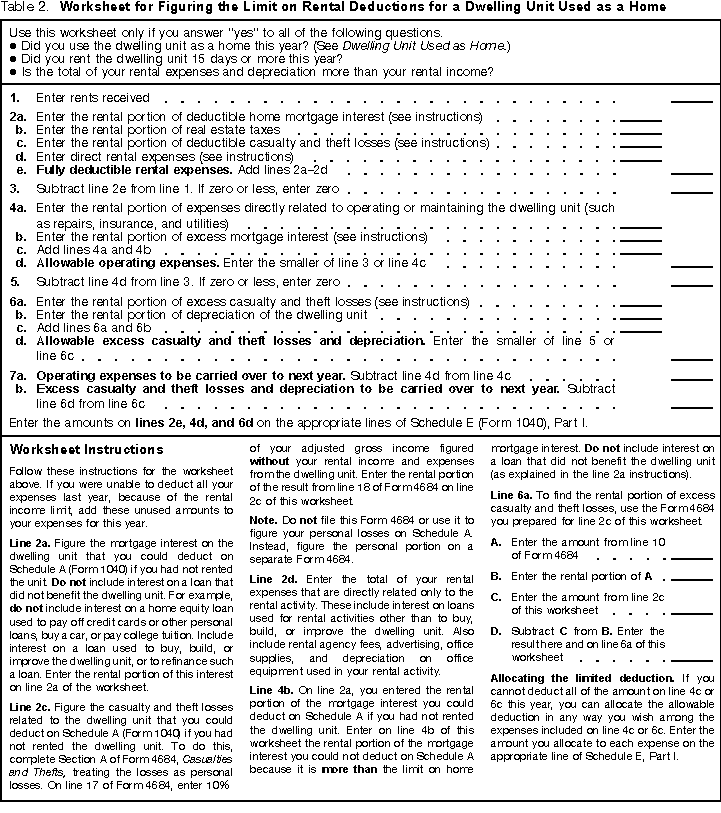Publication 527 Residential Rental Property; Limits on Rental Losses
Post on: 24 Июнь, 2015 No Comment

Limits on Rental Losses
Rental real estate activities are generally considered passive activities, and the amount of loss you can deduct is limited. Generally, you cannot deduct losses from rental real estate activities unless you have income from other passive activities. However, you may be able to deduct rental losses without regard to whether you have income from other passive activities if you materially or actively participated in your rental activity. See Passive Activity Limits. later.
Losses from passive activities are first subject to the at-risk rules. At-risk rules limit the amount of deductible losses from holding most real property placed in service after 1986.
Exception. If your rental losses are less than $25,000, and you actively participated in the rental activity, the passive activity limits probably do not apply to you. See Losses From Rental Real Estate Activities, later.
Property used as a home. If you used the rental property as a home during the year, the passive activity rules do not apply to that home. Instead, you must follow the rules explained under Personal Use of Dwelling Unit (Including Vacation Home), earlier.
At-Risk Rules
The at-risk rules place a limit on the amount you can deduct as losses from activities often described as tax shelters. Losses from holding real property (other than mineral property) placed in service before 1987 are not subject to the at-risk rules.
Generally, any loss from an activity subject to the at-risk rules is allowed only to the extent of the total amount you have at risk in the activity at the end of the tax year. You are considered at risk in an activity to the extent of cash and the adjusted basis of other property you contributed to the activity and certain amounts borrowed for use in the activity. See Publication 925 for more information.
Passive Activity Limits
In general, all rental activities (except those meeting the exception for real estate professionals, below) are passive activities. For this purpose, a rental activity is an activity from which you receive income mainly for the use of tangible property, rather than for services.
Limits on passive activity deductions and credits. Deductions for losses from passive activities are limited. You generally cannot offset income, other than passive income, with losses from passive activities. Nor can you offset taxes on income, other than passive income, with credits resulting from passive activities. Any excess loss or credit is carried forward to the next tax year.
For a detailed discussion of these rules, see Publication 925 .
You may have to complete Form 8582 to figure the amount of any passive activity loss for the current tax year for all activities and the amount of the passive activity loss allowed on your tax return. See Form 8582 not required under Losses From Rental Real Estate Activities, later, to determine whether you have to complete Form 8582.
Exception for Real Estate Professionals
Rental activities in which you materially participated during the year are not passive activities if for that year you were a real estate professional. Losses from these activities are not limited by the passive activity rules.
For this purpose, each interest you have in a rental real estate activity is a separate activity, unless you choose to treat all interests in rental real estate activities as one activity.
If you were a real estate professional for 2001, complete line 42 of Schedule E (Form 1040).
Real estate professional. You qualified as a real estate professional for the tax year if you met both of the following requirements.
- More than half of the personal services you performed in all trades or businesses during the tax year were performed in real property trades or businesses in which you materially participated.
- You performed more than 750 hours of services during the tax year in real property trades or businesses in which you materially participated.
Do not count personal services you performed as an employee in real property trades or businesses unless you were a 5% owner of your employer. You were a 5% owner if you owned (or are considered to have owned) more than 5% of your employer’s outstanding stock, or capital or profits interest.

If you file a joint return, do not count your spouse’s personal services to determine whether you met the preceding requirements. However, you can count your spouse’s participation in an activity in determining if you materially participated.
Real property trades or businesses. A real property trade or business is a trade or business that does any of the following with real property.
- Develops or redevelops it.
- Constructs or reconstructs it.
- Acquires it.
- Converts it.
- Rents or leases it.
- Operates or manages it.
- Brokers it.
Material participation. Generally, you materially participated in an activity for the tax year if you were involved in its operations on a regular, continuous, and substantial basis during the year. For more information, see Publication 925 .
Participating spouse. If you are married, determine whether you materially participated in an activity by also counting any participation in the activity by your spouse during the year. Do this even if your spouse owns no interest in the activity or files a separate return for the year.
Choice to treat all interests as one activity. If you were a real estate professional and had more than one rental real estate interest during the year, you can choose to treat all the interests as one activity. You can make this choice for any year that you qualify as a real estate professional. If you forgo making the choice for one year, you can still make it for a later year.
If you make the choice, it is binding for the tax year you make it and for any later year that you are a real estate professional. This is true even if you are not a real estate professional in any intervening year. (For that year, the exception for real estate professionals will not apply in determining whether your activity is subject to the passive activity rules.)
See the instructions for line 23 of Schedule E (Form 1040) for information about making this choice.
Losses From Rental Real Estate Activities
If you or your spouse actively participated in a passive rental real estate activity, you can deduct up to $25,000 of loss from the activity from your nonpassive income. This special allowance is an exception to the general rule disallowing losses in excess of income from passive activities. Similarly, you can offset credits from the activity against the tax on up to $25,000 of nonpassive income after taking into account any losses allowed under this exception.
If you are married, filing a separate return, and lived apart from your spouse for the entire tax year, your special allowance cannot be more than $12,500. If you lived with your spouse at any time during the year and are filing a separate return, you cannot use the special allowance to reduce your nonpassive income or tax on nonpassive income.
The maximum amount of the special allowance is reduced if your modified adjusted gross income is more than $100,000 ($50,000 if married filing separately).
Example. Jane is single and has $40,000 in wages, $2,000 of passive income from a limited partnership, and $3,500 of passive loss from a rental real estate activity in which she actively participated. $2,000 of Jane’s $3,500 loss offsets her passive income. The remaining $1,500 loss can be deducted from her $40,000 wages.
Active participation. You actively participated in a rental real estate activity if you (and your spouse) owned at least 10% of the rental property and you made management decisions in a significant and bona fide sense. Management decisions include approving new tenants, deciding on rental terms, approving expenditures, and similar decisions.
Example. Mike is single and had the following income and losses during the tax year:














